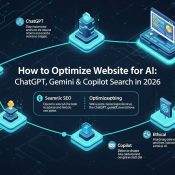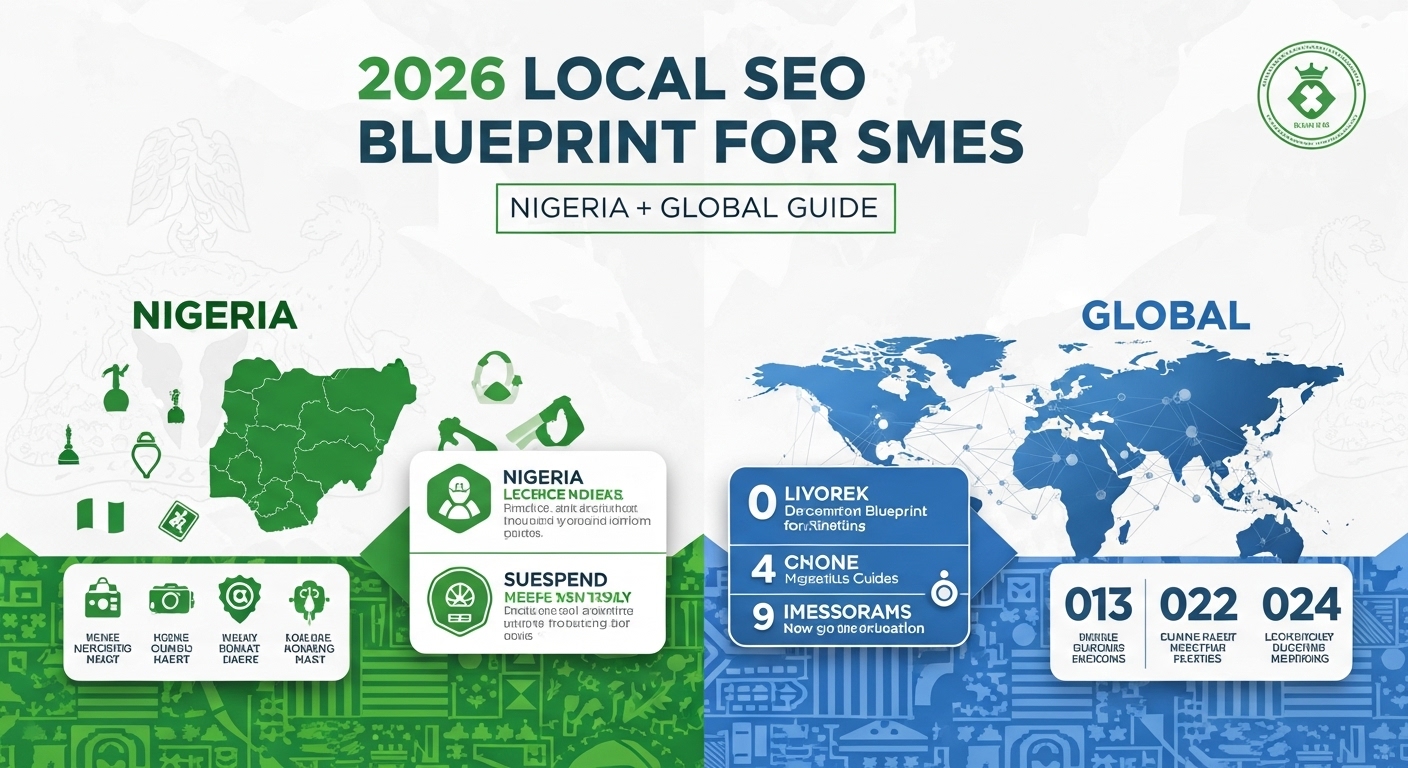
2026 Local SEO Blueprint for SMEs (Nigeria + Global Guide)
2026 Local SEO Blueprint for SMEs (Nigeria + Global Guide)
In 2026, local search has evolved into one of the most influential discovery channels for small and medium businesses (SMEs). Whether a business operates in Lagos, Nairobi, New York, or London, the customer journey increasingly begins with a location-based search such as:
- “restaurants near me”
- “best website designer in Abuja”
- “car repair shop in Lekki Phase 1”
- “SEO agency near me”
- “mobile money agent nearby”
- “local legal services in London”
Google’s shift towards AI-powered search (SGE), localized intent modelling, and entity-based ranking systems means SMEs MUST rethink their approach to online visibility. Local SEO is no longer about listing a business on Google Maps. It is now a full-scale reputation, content, technical, and trust-building system.
ALSO, READ Integrated Marketing for SMEs: SEO, Security & Cloud Guide
Across Nigeria and the global SME ecosystem, businesses that master local SEO enjoy measurable competitive advantages:
- Higher qualified leads
- Lower customer acquisition cost
- Greater trust and brand credibility
- Increased conversions from high-intent local searches
- Reduced reliance on paid advertising
This article presents the 2026 Local SEO Blueprint — a professional corporate guide designed to help Nigerian and international SMEs build long-term visibility, outperform competitors, and scale revenues using proven, research-backed methodologies.
It also features real case studies from international brands and Nigerian companies whose local SEO strategies contributed significantly to their growth.
SECTION 1 — WHY LOCAL SEO MATTERS IN 2026
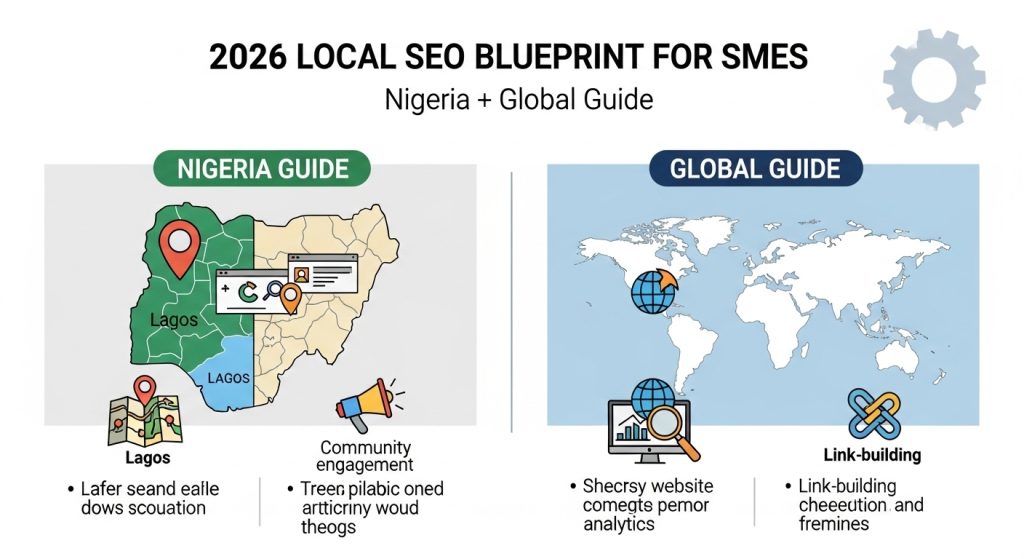
The Strategic Importance for Nigerian and Global SMEs
1.1 The Rise of “Near Me” Behaviour Across All Industries
Google reports that over 76% of local searches lead to a visit within 24 hours. Local search intent has become more transactional—meaning users searching for nearby services are ready to purchase or engage immediately.
This applies across sectors:
- Restaurants
- Healthcare providers
- Real estate
- Ecommerce pickup locations
- Professional service firms
- Agencies
- Financial institutions
- Education and training centres
1.2 Nigeria’s Digital Explosion
Nigeria currently has over 156 million internet users, making it one of the fastest-growing online markets globally (NCC, 2025). SMEs that rank locally capture customers faster because Nigerians trust businesses they can verify physically or through proximity-based credibility.
1.3 Global Evolution of Local Search: AI Overlays Everything
By 2026:
- Google’s SGE prioritizes entities, trust signals, structured data, and local authority.
- Voice search adoption increases the volume of contextual “near me” queries.
- Hyperlocal intent (street-level accuracy) becomes standard for mobile search.
- Google is merging reputation, content, website quality, and location signals into ranking decisions.
SMEs that adapt early will dominate their markets.
SECTION 2 — THE FOUR PILLARS OF LOCAL SEO IN 2026
A Strategic Framework for Sustainable Visibility
The 2026 Local SEO Blueprint consists of four corporate-level pillars:
Pillar 1: Local Presence Optimization (LPO)
This covers everything a business needs to appear consistently across local platforms:
- Google Business Profile Optimization
- Bing Places
- Apple Maps
- MapPack readiness
- Local directory citations
- NAP (Name, Address, Phone) consistency
- Service-area accuracy
- Geo-tagged visual assets
Businesses with strong LPO benefit from:
- Higher MapPack rankings
- Enhanced trust signals
- Increased foot traffic and calls
- Better local brand authority
Pillar 2: Local Content Authority (LCA)
Local content drives conversions. In 2026, generic articles do not rank. Google prioritizes:
- Hyperlocal service pages
- Local landing pages
- Location-based blog posts
- Industry-specific local authority guides
- City and neighbourhood-targeted content
- AI-verified entity topical relevance
Local content must be factual, helpful, professional, and specific.
Pillar 3: Technical Local SEO (TLS)
Technical elements now play a major role in local rankings:
- Core Web Vitals (2026 requirements are stricter)
- Local schema markup
- Service area schema
- Review schema
- Geolocation metadata
- Mobile-first infrastructure
- Fast-loading map integrations
- Secure website (HTTPS + security configurations)
- Local internal linking architecture
Any SME with poor technical foundations will struggle to rank regardless of content quality.
Pillar 4: Local Reputation & Trust Signals (LRTS)
In 2026, online reviews and trust signals weigh heavily in local rankings:
- Review velocity (steady review growth)
- Review diversity (Google, Facebook, Trustpilot, etc.)
- Review quality
- Review sentiment analysis
- Q&A consistency
- Verification badges
- Local community engagement signals
Google confirms that reviews influence:
- Position in the MapPack
- Conversion rates
- Click-through rate
- Website visits
- Brand trust perception
A business with 200+ positive, recent reviews will outrank a business with outdated or inconsistent reviews.
SECTION 3 — STEP-BY-STEP 2026 LOCAL SEO BLUEPRINT FOR SMEs
This section outlines the precise 2026 methodology your business MUST follow.
Step 1: Conduct a Local SEO Audit (2026 Version)
A complete audit includes:
1. Local Search Visibility Audit
- MapPack ranking status
- Visibility across multiple locations
- Search engine indexation
- Local keyword gap analysis
2. Google Business Profile Audit
- Category accuracy
- NAP consistency
- Geotagged images
- Product & service listing optimization
- Review performance
- Local post frequency
3. Website Audit
- Core Web Vitals (2026 standards)
- Local schema
- Load speed
- Security readiness
- Internal link structure
- Local landing pages
4. Reputation Audit
- Review score
- Review sentiment
- Review velocity
- Competitor benchmarking
5. Competitor Local Authority Audit
Analyze the local competitors with the highest performance in:
- Link authority
- Local citations
- Review strength
- Content authority
- Entity validation
A 360º audit provides clarity on what Google sees—and what needs immediate improvement.
Step 2: Optimize Google Business Profile Using 2026 Standards
GBP optimization in 2026 requires a structured approach:
Key Actions
- Set primary and secondary categories properly
- Add all business services with keyword-rich descriptions
- Upload geotagged high-resolution images
- Add products (even service businesses must use this feature)
- Implement weekly GBP posts
- Add FAQs and respond promptly
- Use UTM tracking for links
- Ensure 100% profile completeness
- Maintain consistent office hours
- Add appointment links, forms, and call tracking
SMEs that treat Google Business Profile like a micro-website always outperform competitors.
ALSO, READ Ethical Data Marketing 2026: Privacy-First Strategy Guide
Step 3: Build Hyperlocal Landing Pages & Local Content
Every SME needs:
- A landing page for each service
- A landing page for each city or area served
- Local blog topics targeting regional intent
- Local case studies and community involvement sections
- Pages structured to include:
- Local schema
- Geo-coordinates
- Local FAQs
- Local backlinks
Businesses ranking in multiple cities must create individual pages per target location (e.g., “Web Design in Abuja”, “Web Design in Lagos”, etc.).
SECTION 4 — ADVANCED LOCAL SEO STRATEGIES FOR 2026
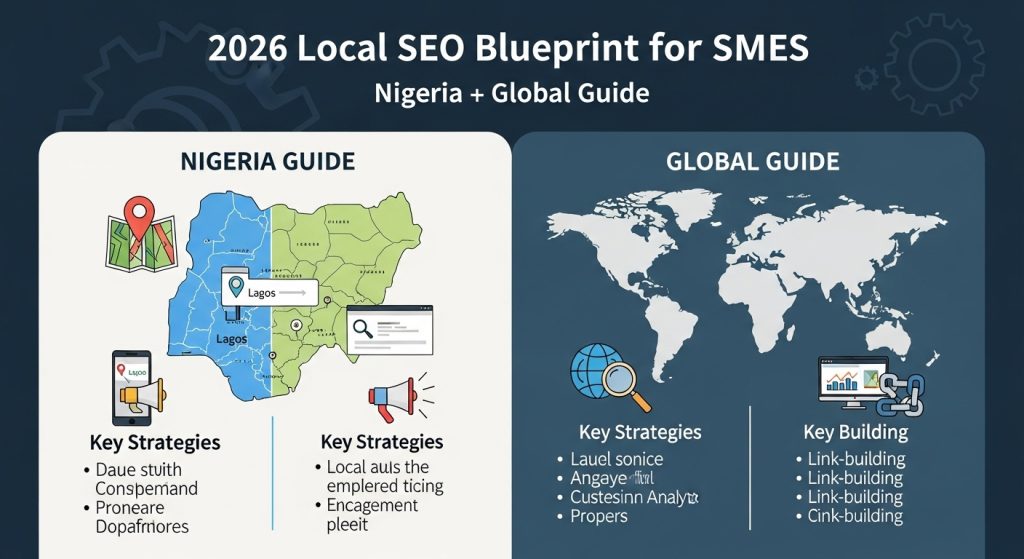
These are the strategies separating average SMEs from top-performing market leaders.
Step 4: Implement Local Schema Markup & Entity Signals
In 2026, structured data has become fundamental. Google’s AI-first indexing relies heavily on machine-readable data to understand:
- Who your business is
- Where you operate
- What service area you serve
- What customers think about you
- Your brand authority
Priority Schemas for SMEs
- Local Business Schema (mandatory)
- Service Schema (for each service)
- FAQ Schema
- Review Schema
- Product Schema (for service businesses, too)
- GeoCoordinates Schema
- Opening Hours Specification
Entity Establishment Signals
To become an “entity” in Google’s ecosystem (which increases ranking potential), SMEs must:
- Use consistent NAP across all platforms
- Maintain strong branded searches
- Build author & organization schema
- Publish expert-led content
- Maintain a trusted web footprint (citations, mentions, media references)
Businesses with strong entity signals dominate local rankings effortlessly.
Step 5: Build Local Backlinks & Digital Citations
Google confirmed that local backlinks are one of the strongest indicators of authority.
Recommended citation sources
- Google Business Profile
- Bing Places
- Apple Maps
- Yelp
- Facebook Business Pages
- Yellow Pages Nigeria
- VConnect
- BusinessList
- Nairaland Business Section mentions
- Crunchbase (for established companies)
- Local chambers of commerce
- Local directories in targeted cities
Local Authority Backlinks
SMEs must actively target:
- Local blogs
- Community websites
- Local journalists
- City-based publications
- Industry associations
- Event sponsorship backlinks
These links help Google confirm geographical relevance.
Step 6: Establish a Strong Local Reputation System
Reputation now directly affects both ranking and conversion.
Key Components of a 2026 Reputation Strategy
- Weekly request for reviews from active customers
- Responses to every review within 48 hours
- Review acquisition from multiple platforms (Google, Facebook, Trustpilot, etc.)
- Q&A monitoring on Google Business Profile
- Building local testimonials and video reviews
- Maintaining high review sentiment score (4.4+ rating)
Google uses AI to evaluate review sentiment: businesses with positive descriptions (clean, fast, quality, trustworthy, responsive) rank higher.
Step 7: Optimise for AI Search, Voice Search & Hyperlocal Mobile Queries
In 2026, nearly 62% of local searches come from voice assistants and mobile micro-moments.
Your content must answer:
- “Where can I find…?”
- “What is the best… near me?”
- “Who offers… in this area?”
- “Is there a… open now?”
Voice-ready content requires:
- Short, direct, answer-based content
- FAQ schema
- Hyperlocal phrases
- Natural language formatting
If your business cannot be easily “spoken back” by voice assistants, it will lose customers in 2026.
SECTION 5 — REAL CASE STUDIES (NIGERIA + GLOBAL)
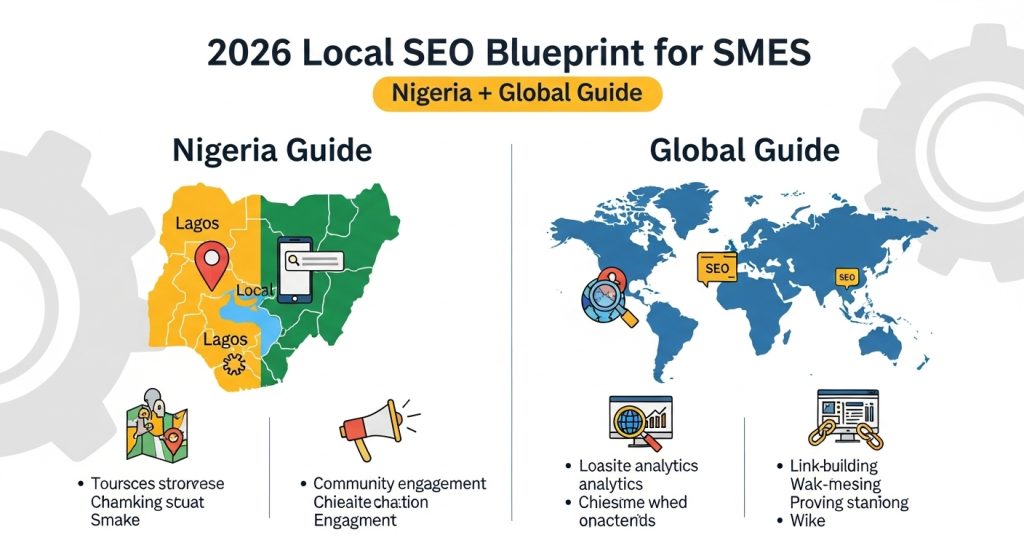
These case studies are based on publicly available performance data and strategic insights.
No confidential information is included.
CASE STUDY 1 — Domino’s Pizza Nigeria
How Local SEO + Geo-Targeting Increased Foot Traffic
Domino’s Pizza Nigeria implemented a smart combination of:
- Area-specific landing pages (Lekki, Gbagada, Abuja, Ikeja, etc.)
- Google Business Profile optimization per branch
- High-frequency review systems
- Location-based delivery keywords
- Local backlink citations from food blogs and magazines
Impact (publicly reported trends):
- Improved MapPack dominance in Lagos & Abuja
- Increased delivery orders
- Visibility for “pizza near me” searches across Nigeria
- Higher foot traffic during peak hours
Domino’s proves that multi-location local SEO is a growth engine when executed consistently.
CASE STUDY 2 — GTBank (Guarantee Trust Bank)
Winning Local Discovery Through Branch-Level Optimization
GTBank’s nationwide visibility is supported by:
- Optimized Google Business Profiles for each branch
- Accurate NAP and opening hours
- Customer reviews at branch level
- Structured data implementation on main website
- Integration of branch-level micro pages
Outcomes:
- High visibility for searches such as “GTBank near me,” “GTBank ATM near me,” and “bank open now.”
- Increased customer trust due to accurate branch listings.
- Smooth discovery for new customers and international visitors.
GTBank demonstrates the importance of accurate data + local branch optimization.
CASE STUDY 3 — Jumia (Africa’s Largest Marketplace)
Leveraging Local Search Intent for Marketplace Dominance
Jumia consistently ranks for high-intent local searches due to:
- Massive product schema implementation
- Local SEO content for categories
- High authority backlinks
- Accurate location and delivery information
- Entity-level dominance in African ecommerce
Visible Impact (publicly known):
- Increased organic traffic for local product queries
- Brand reinforcement across major African markets
- Strong presence for “where to buy…” searches
This reinforces that content depth + structured data = local ranking power.
CASE STUDY 4 — Warby Parker (USA)
How Local SEO Built a $3 Billion Brand
Warby Parker used:
- Location-specific landing pages
- Geo-optimized metadata
- Local reviews for each branch
- Authority backlinks from media
- Local schema across all store locations
Public results:
- Very high MapPack visibility in major U.S. cities
- Increased in-store bookings
- Seamless discovery for customers searching “eyeglasses near me”
This case proves global SMEs can scale revenue via multi-location local visibility.
CASE STUDY 5 — Sweetgreen (USA)
Local SEO for a Restaurant Chain
Sweetgreen uses:
- Google Business Profile optimization
- High-frequency review generation
- Local influencer partnerships generating local backlinks
- Hyperlocal ads backed by SEO data
Results:
- Strong dominance for “healthy food near me” searches
- Increased store traffic
- Strong urban market penetration
Their strategy highlights the importance of localized content + reviews + consistent data.
CASE STUDY 6 — Innocent Drinks (UK)
Local Search & Brand Trust Signals
Innocent Drinks optimized:
- Google Business Profile
- Local store distribution pages
- Local content & brand storytelling
- Community activities supporting review sentiment
Results:
- Increased local product discovery
- Strong brand trust
- Easier retailer visibility
This case shows the impact of community + local content.
SECTION 6 — LOCAL SEO FOR SERVICE-BASED BUSINESSES (HIGH-LEAD INDUSTRIES)
Local SEO is especially powerful for industries where customers need fast, location-based service.
High-conversion industries include:
- Law firms
- Clinics & hospitals
- Restaurants
- Real estate
- Digital marketing agencies
- Web design companies
- Cybersecurity providers
- Banking & fintech
- Repair services
- Logistics & delivery
- Fitness & wellness centres
- Education & training
Typical Local SEO impact:
- 40–300% increase in calls
- 60% more direction requests
- 2× increase in walk-ins and service bookings
- Dramatic reduction in paid ads spend
Service businesses gain the MOST from local SEO because their customers are motivated, local, and ready to decide quickly.
SECTION 7 — THE 2026 IMPLEMENTATION ROADMAP (FULL EXECUTION PLAN)
This final section outlines a corporate-grade, actionable roadmap SMEs can use to implement local SEO properly, sustainably, and profitably.
This roadmap is the same process used by top-performing agencies worldwide — including what you offer at 24SevenHub.co.
PHASE 1 — DISCOVERY & AUDIT (Week 1–2)
A professional local SEO campaign begins with diagnostics.
Key Deliverables
- Full website audit
- Google Business Profile evaluation
- Local visibility benchmarking
- Competitor local authority analysis
- Review sentiment analysis
- Technical SEO scan
- Brand entity & NAP consistency assessment
The goal is to document the current baseline before taking action.
PHASE 2 — GOOGLE BUSINESS PROFILE OPTIMIZATION (Week 2–4)
Tasks
- Add correct categories & subcategories
- Upload 20–40 geotagged photos
- Add products/services with descriptive keywords
- Configure UTM tracking for GBP
- Write optimized business descriptions
- Set accurate opening hours
- Add appointment links & messaging
- Activate Q&A section
Deliverables
- GBP fully optimized (90–100% score)
- Business positioned for MapPack visibility
PHASE 3 — LOCAL CONTENT & LANDING PAGE CREATION (Week 4–8)
SMEs need a content ecosystem, not a blog with random posts.
Content Requirements
- Service pages (fully optimized)
- City-specific landing pages
- Industry-specific local guides
- Local FAQs
- Local service comparison pages
- Case study pages
- Evergreen local blogs
Example
A web design agency should have pages like:
- Web Design in Abuja
- Web Design in Lagos
- SEO Services in Port Harcourt
- Cybersecurity Services for SMEs
Each page targets hyperlocal intent to capture search demand.
PHASE 4 — TECHNICAL LOCAL SEO CONFIGURATION (Week 6–10)
This ensures the website meets 2026 Google technical expectations.
Technical Deliverables
- Core Web Vitals optimization
- Mobile-first performance
- Local business schema
- FAQ schema
- Service schema
- GeoCoordinates schema
- Security fixes (HTTPS, HSTS, firewall)
- Crawl depth optimization
- Local internal linking
A technically weak website cannot rank, regardless of content quality.
PHASE 5 — LOCAL BACKLINKS, CITATIONS & AUTHORITY (Week 8–12)
This stage builds trust and authority around your business.
Authority Actions
- Directory submissions
- Chamber of Commerce mentions
- Local newspaper mentions
- Guest posts on local blogs
- Sponsorship of local events
- Podcast appearances
- Strategic partnerships
- Brand PR releases
Citations Needed
At least 40–100 citations across reputable directories.
This creates a digital footprint Google can verify.
PHASE 6 — REVIEW MANAGEMENT & LOCAL TRUST SYSTEM (Week 10–ongoing)
Google prioritizes businesses with:
- Many recent reviews
- High review velocity
- Positive sentiment
- Owner responses
- Multi-platform review presence
Reputation Assets to Build
- Google reviews
- Facebook reviews
- Trustpilot reviews
- Video testimonials
- Case studies
Reviews now directly influence ranking, click-through rate, and conversions.
PHASE 7 — AI SEARCH, VOICE, & MOBILE OPTIMIZATION (Week 12–ongoing)
Implementation Steps
- Rewrite content into short, voice-friendly sentences
- Add conversational FAQs
- Optimise for long-tail natural queries
- Structure sections so AI assistants can extract answers
- Use zero-click formats for rich snippet capture
- Add “near me” semantic signals
SMEs optimized for voice search outperform competitors struggling to adapt.
PHASE 8 — PERFORMANCE MONITORING (Week 12–52)
Local SEO is continuous, not a one-time task.
Weekly Monitoring
- GBP insights
- Review velocity
- Local keyword rankings
- Calls, direction requests, messages
- Search impressions
- CTR on local results
Monthly Reporting
- Traffic growth
- Local authority gains
- Competitor changes
- New keyword opportunities
- Review sentiment score
This ensures sustained growth into 2026 and beyond.
CONCLUSION — THE 2026 LOCAL SEO ADVANTAGE
Local search has become the most reliable and cost-efficient way for SMEs to acquire customers in 2026. Whether an SME operates in Lagos, Abuja, London, New York, or Nairobi, local SEO serves as the backbone of trust, authority, and visibility.
SMEs that invest in:
- Strong technical foundations
- Geographic relevance
- Content depth
- Reputation systems
- Real entity signals
will dominate their industries, reduce marketing costs, and unlock unlimited organic traffic.
In a world where customers rely heavily on proximity-based discovery, local SEO is no longer optional — it is an essential business growth strategy.
Ready to Dominate Local Search in 2026?
24SevenHub offers industry-leading Local SEO, Web Design, Cybersecurity, and Digital Growth solutions tailored for SMEs across Nigeria and globally.
Whether you’re a startup, SME, or enterprise, our team provides:
- Full Local SEO Management
- Website Design & Optimization
- Technical SEO & Core Web Vitals Fixes
- Google Business Profile Management
- Reputation & Review Systems
- Local Market Domination Strategies
👉 Visit 24SevenHub.co today
👉 Request a free Local SEO audit
👉 Start ranking where your customers are searching



